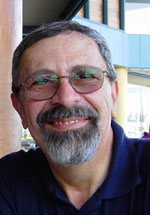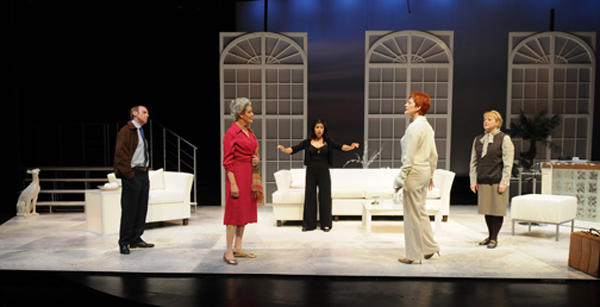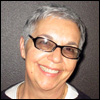| |
|


PETE'S PLACE
Double standard: journalists shed no tears for Ukrainians denied Russian heating oil
By Peter Garas
 CANBERRA, Australia—Media reports have presented us with yet another unique opportunity to look at the hypocrisy of the world's press. CANBERRA, Australia—Media reports have presented us with yet another unique opportunity to look at the hypocrisy of the world's press.
The estimated total population of the Ukraine is 46,299,862 yes folks, you read that right, over 46 and a quarter million people, who as of today will be really short of electricity, heating and cooking supplies because the Russian monopoly Gazprom (whose head just happens to be the new President elect) has cut their supply of gas to this country by yet another 25%, bringing this to a 50% supply cut in the space of a few weeks.
As indicated to you before by this author, the people of the Ukraine are not firing rockets across the border, nor are they sending suicide bombers into the territory of "Mother Russia."
According to them they are paying their bills and the Russians are simply denying them supplies. Russia of course alleges that they have not paid their bills.
Meanwhile potentially 46,299,862 are doing without heat and cooking facilities and electricity because of a dispute between two governments.
Is there an outcry in the media about the potential genocide that is being committed by the Russians? Is there some international concern being expressed for these millions of people and their plight?
Not really.
It seems that no one gives a damn about the millions of civilians at risk in spite of the fact that the winter weather has not yet dissipated in that area.
Meanwhile, with each day that passes Palestinians fire murderous rocket barrages across the border into Israel, which valiantly tries to defend itself with just some of the means at its disposal. Palestinians are getting press attention each time that a so-called civilian dies or is injured, either as a result of the retaliatory strikes or the embargo on supplies to the Hamas controlled territory of Gaza.
What would be required for the Israelis to stop their embargo and stop their air strikes?
Simple - for Hamas to stop firing rockets across the border aimed at civilian targets in Israel and sending suicide bombers across the border to try and blow up innocent civilian targets.
Not really much to ask, and yet the Israelis are painted as the monsters.
There is only one American saying that can possibly describe this form of behaviour by journalists: "Go figure!"
Of course another explanation could be anti Semitism!






Lecturer says Sydney Taylor’s children’s books intrigue audiences of all ages
By Yvonne Greenberg
SAN DIEGO—"In the five-book All-of-a-Kind Family series by Jewish-American author Sydney Taylor, “children are portrayed as friendly, warm, sociable, a little bit adventuresome, honest and good," notes June Cummins, an associate professor at San Diego State University, where she specializes in children's literature and Jewish-American Literature. "They are not always little angels, sometimes they make mistakes and get into trouble, but they learn from their mistakes and have very good hearts."
The All-of-a-Kind Family series, Taylor's most famous books, were the first to feature Jewish children that reached a mainstream audience. Beginning in 1951 and continuing today, the series has been read by millions and are often young readers' first introduction to Jews.
Cummins, a recent lecturer in the Mandelbaum Family Lecture Series sponsored by the Agency for Jewish Education in Coronado, said that Taylor carefully infused her stories and characters with Jewish values. In doing so, Taylor contributed to creating a post-war American Jewish identity through children's literature.
"I would say Sydney Taylor's dream for American-Jewish children would be to be American without giving up being Jewish ,” the professor told an interviewer. “She believes in strong family ties, in education, and in following your dream. Through her characters, she encouraged her readers to be active and fully engaged in all their endeavors, whether an endeavor was putting on a play, or helping someone in need, or celebrating Jewish holidays, or even just playing games. Throughout her stories Taylor also subtly advocated ideals we would consider progressive, such as feminism, social work, and respect for blue-collar workers, I believe Taylor's softly progressive politics stem from the strong involvement she and many other young Jewish people of the early 20th century had with socialism and other liberal perspectives."
Cummins said that "I and many others were influenced by the author. So it's not surprising we agree with her!
She reported that interest in Taylor transcends age barriers: “I have talked to many audiences about Sydney Taylor, ranging from fourth graders in elementary schools to academic colleagues at national conferences to senior citizens at public libraries (such as the Coronado Public Library).”
Her next public lecture on Jewish children's literature will take place in June in Cleveland at the Association of Jewish Libraries meeting.The AJL is the organization that gives the Sydney Taylor Award for excellence in Jewish children‘s literature. This upcoming talk will focus on what I call ‘Jewish chick-let lit', "that is, books for Jewish pre-teenage and young teenage girls."
Cummins her Ph.D. from University of California Berkeley. Her research interests include multiculturalism, ethnic identities, feminism, and consumerism, among others.



 
THE JEWISH CITIZEN 'A Jewish Story Everywhere'
The Zoo as textbook for religious studies
By Donald H. Harrison
 SAN DIEGO—Just as in Jerusalem, different passages of Jewish scriptures can be brought to life by visiting the zoo here-- especially if one brings along a listing of biblical animals such as is easily available on Wikipedia or from other web sources. SAN DIEGO—Just as in Jerusalem, different passages of Jewish scriptures can be brought to life by visiting the zoo here-- especially if one brings along a listing of biblical animals such as is easily available on Wikipedia or from other web sources.
 When I parked this morning at the San Diego Zoo, it was in section 10, marked by an elephant sign. As I walked up to the Zoo, I noticed a giant topiary reproduction of an elephant. Passing that, the sign over the entryway featured a large elephant among other animals. Okay, okay, I thought, an elephant it is. Assuming my walking companions—Shimon Camiel, Ron Reff and Dan Schaffer—agreed, we would hoof it to the elephant enclosure. When I parked this morning at the San Diego Zoo, it was in section 10, marked by an elephant sign. As I walked up to the Zoo, I noticed a giant topiary reproduction of an elephant. Passing that, the sign over the entryway featured a large elephant among other animals. Okay, okay, I thought, an elephant it is. Assuming my walking companions—Shimon Camiel, Ron Reff and Dan Schaffer—agreed, we would hoof it to the elephant enclosure.
Ever agreeable, my fellow walkers had no trouble remembering where in Scriptures one can find references to an elephant. The Book of Maccabees, they said. When Judah and his brothers are fighting the Syrians, Eleazar sees one elephant that is bigger and is outfitted with fancier accoutrements than any of the others. Assuming that was therefore the elephant of the king, Eleazar maneuvered through the battle lines, got under the elephant, and speared it. Down crashed the elephant, crushing the brave Eleazar. But it was for naught; the king was not aboard the great beast. (I Macabees 6: 43-46). The Macabees thereafter withdrew their battle line.
It’s a sad yet instructive story: both Eleazar and the magnificent elephant died as a result of mistaken identity. Clearly, in battle as well as in peacetime, it’s a good idea to have proper intelligence, to know your facts before you jump into a situation from which possibly you may be unable to extricate yourself.

Besides lessons from scriptures, the visit to the elephant pens, which soon will be relocated to another part of the Zoo, offered additional opportunities for learning. Zoo signage informed that “African elephants have larger ears than the Asian species. Their skin is wrinkly, their back is swayed and the end of their trunk has two fingers. Both males and females have visible tusks. … The elephant is the largest and heaviest land animal. Its trunk—a combination of nose and upper lip—can grab leaves from a tree or suck up water from a pond. Ivory tusks used for defense and for digging are its only front teeth. Flapping those huge ears helps keep an elephant cool . Asian elephants have smaller ears than their African counterparts; their skin is smooth, their back is dome-shaped, and they have one finger at the end of their trunk. Usually only the males have visible tusks…”
Aware that San Diego is a semi-desert, the San Diego Zoo tells how elephants are made to participate in a water conservation program. “There is no way around it,” declares a sign. “Elephants are big water users. They drink as much as 50 gallons per day per elephant. They dip their hay in water and they squirt it and splash in it. So how do we save a mammoth amount of water here? We clean the elephant’s pool less often. Instead of every other day, we now drain the 60,000 gallon pool only when necessary.”
The Zoo also shows how it plans to move the elephants. It has a structure which elephants may enter and exit – a play environment if you will. Eventually the elephants will become so used to the structure that they will not hesitate to go inside. On moving day, the entrance and exit will be closed, making a rolling cage for the elephants. Then they will be towed to their new home in another part of the zoo. It should be fascinating to watch.
  . .
As I took photographs of the elephants, I remembered the old tale about the three blind men and the elephant. Each felt a different part of the animal, and each came up with a different description of what the creature might be. As I looked at the tusk, the wrinkled skin, a large eye, I thought how easy it might be to concentrate on a small part of something and completely misapprehend the whole.



ARTS IN REVIEW
The Clean House plays to a pleased house
By Carol Davis
 SAN DIEGO—I hate inside jokes…especially when they are told in Portuguese; and that’s not a joke. No kidding. Playwright Sarah Ruhl has a new play called The Clean House that now is being given its West Coast Premiere at The San Diego Repertory Theatre downtown through March 22. It’s the last show of the season for the Rep. and a fun way to end it at that. It won her a Pulitzer Prize along with the Susan Smith Blackburn prize for Best Play by a Female Playwright. Ruhl’s new comedy is whimsical, witty, wacky, and wickedly funny, sometimes. And OH! The first five minutes of the show were taken up with the telling of a joke, in non-translatable Portuguese. SAN DIEGO—I hate inside jokes…especially when they are told in Portuguese; and that’s not a joke. No kidding. Playwright Sarah Ruhl has a new play called The Clean House that now is being given its West Coast Premiere at The San Diego Repertory Theatre downtown through March 22. It’s the last show of the season for the Rep. and a fun way to end it at that. It won her a Pulitzer Prize along with the Susan Smith Blackburn prize for Best Play by a Female Playwright. Ruhl’s new comedy is whimsical, witty, wacky, and wickedly funny, sometimes. And OH! The first five minutes of the show were taken up with the telling of a joke, in non-translatable Portuguese.
That aside, artistic director Sam Woodhouse and his talented cast of five (four women and one guy) are giving Ruhl’s piece a capricious and entertaining airing. The set up is as follows: Lane (Rosina Reynolds) and Charles (Ron Chularton) are both doctors who met in Medical School. Theirs is not what one would call a close relationship at present. He works all the time and she manages to get home once in a while. Home is stark, a rather sterile looking place that is need of constant cleaning up. (Victoria Petrovich designed an all white furniture living room with plexiglass and glass tables and ornaments, a short flight of stairs off in the back side for exits and entrances) Lane confesses that she did not go to Medical School to clean houses. Her cleaning girl is Matilde (Claudia Vázquez). She hates to clean, is depressed about it but loves to tell jokes. Her mother died laughing at one of her father’s jokes. Virginia, (Annie Hinton) is Lane’s sister. She is a compulsive cleaner. “Those who give up cleaning their own houses are insane” (Please commit me!) She even wanted to sweep up old ruins of an archeological finding.
Virginia convinces Matilde to let her come and clean Lane’s house while Matilde searches out the ‘perfect joke’ and still collects her paycheck from Lane. While folding the laundry one afternoon, both women discover some suspicious looking underwear in the basket. You guessed it. Charles has a lover. Bada bing!
While operating on one of his older patients (Ana) for breast cancer, Ana (Ivonne Call) and Charles fall in love. It gets more bizarre. Charles brings Ana home for a kumbayah moment over the objections of Lane, who doesn’t seem to ‘get it.” Sitting on their all-to lily-white living room sofa, trying to explain it, Ana says, “There’s a midrash that says when a baby is forty days old in its mother’s stomach, God picks out his soul mate, and people have to spend the rest of their lives running around to find their mates.” We have found ours. In other words, they have met their Beshert! Appalled, Lane snaps back, “You’re not even Jewish!” (That got the biggest laugh of the evening, and was one of the funniest lines as well).
To say that things go from bad to worse would undermine the telling of Ruhl’s play. In fact, things go from weird to weirder, from reality to fantasy from an underlying need to come to grips with one’s life, or ‘clean house’ to the compassion needed to allow it to happen. How it all comes about is at the crux of the play that you need to see to believe. With three very strong women, each powerful in her own right, Ruhl’s The Clean House is in good hands.
Rosina Reynolds is no slouch in the steely eyed, strong capable woman category. She is stunning in her all-white pant suits with matching tops (Jennifer Brown Gittings) very much in control until she meets up with Ana, when her world does an about face. Ivonne Call’s Ana (she plays Matilde’s mother as well) is an absolute pleasure to watch. She is warm, so engaging and so convincing that you almost forget she is a character in a play. Embracing Ana as she does helps tone down the hard edges of Lane’s outer crust and brings reconciliation and change by play’s end. Both actresses are pros and know how to bring the audience into their worlds.
Annie Hinton’s Virginia is as quirky as can be as she waltzes through her days as the polar opposite of her sister in both looks and stature. Her outfits are as much at odds with themselves (with busy designs) as she is to her sister Lane but to watch her you get the idea that you are the eccentric one, not the other way around. She is a hoot to watch. Claudia Vázquez is just OK as the Brazilian housekeeper in search of the ‘perfect joke’, one that’s so funny, it’s rumored to be deadly to those who hear it. She’s too aloof and was not completely convincing on opening night. Ron Chularton’s Charles often looked like the deer in the headlights. Maybe the joke was on us though, as he was able to pull off his character as both shallow and caring at the same time. He does double duty as well as Matilde’s father. Both he and Call looked great doing the tango as her parents and were a scream as Dr. and patient singing in harmony while in the operating room as he is removing her breast in the opening scene of Act II.
For what it’s worth, there is a message hidden in The Clean House about hope, love, compassion and humor which, as we know, goes a long way. It’s worth a try.
See you at the theatre.

SAN DIEGO JEWISH WORLD THE WEEK IN REVIEW
heila Orysiek in San Diego: Kaballah book helps open ears to the Voice
Marissa Palin in San Diego: Beth Israel event focuses on auto emissions
Gary Rotto in San Diego: Surrogates for Clinton and Obama debate for the affection of Ohio Jewish voters
Lynne Thrope in La Jolla, California: Whisknladle: restaurant gets it right
Shoshana Bryen in Washington DC: The Angelina Jolie report on Iraq progress
Peter Garas in Canberra, Australia: No protests over gas cutoff to Ukraine?
Sheila Orysiek in San Diego: Mitzvah equation: difficult equals better?
Ira Sharkansky in Jerusalem: Israel's response in Gaza: long in coming
Judy Lash Balint in Jerusalem: Filmmaker Laura Bialis describes "Only thirty-six hours in Sderot."
Shoshana Bryen in Washington, D.C.: Obama and McCain debate Al Qaeda
Carol Davis in San Diego: Tick, Tick...BOOM at Stone Soup in S.D.
Rabbi Baruch Lederman in San Diego: There is no tempest in this coffee pot
Rabbi Leonard Rosenthal in San Diego: Even Mishkan's building awaits Shabbat
Ira Sharkansky in Jerusalem: Kicking up a fuss over Jonathan's sexuality
Plus Letters to the editor
Carol Davis in Solana Beach, California: A Shayna Maidel: a post-Holocaust story
Peter Garas in Canberra, Australia: Friendship between Muslims and the West would be beneficial for humanity, globe
Yvonne Greenberg in San Diego: Personality in the News—Why San Diego Jewish filmgoers re-Joyce
Link to previous editions
< BACK TO TOP
|
|

 —
—